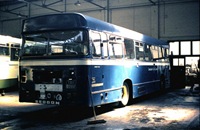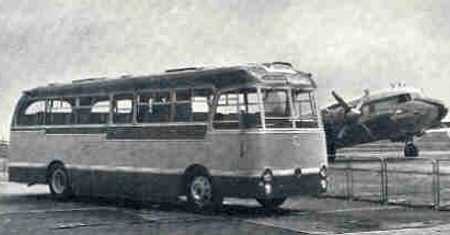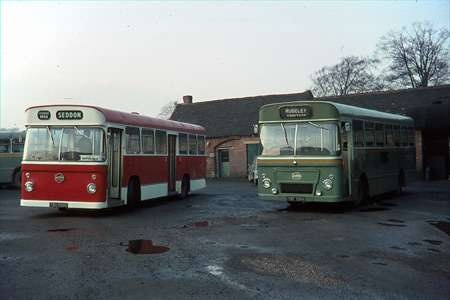Lancaster City Transport – Seddon RU – TBU 598G – 598
Lancaster City Transport
1969
Seddon RU
Pennine B??F
Much has been written, on this website and elsewhere, about the Seddon Pennine. Most of such text is not complimentary. Southampton City Transport had several, with bids for their Gardner engines being far higher than bids for the complete vehicle when they were withdrawn.
TBU 598G was the demonstrator, which Lancaster acquired via Midland Red after that operator had taken over Green Bus of Rugeley. The wife of one of my office colleagues could not get out of her mind the thought that Rugelli [as she pronounced it] was in Wales so, whenever they went from Winchester to York, she would ask "Why are we going via Wales?" I digress!
It is clear that 598, to give her the Lancaster nomenclature, is in no condition for service in this view inside Heysham Road garage on 20 May 1975. Note the missing door for the engine compartment, and the cleaner’s broom, which is having a rest.
Photograph and Copy contributed by Pete Davies
28/10/12 – 10:14
Perhaps the broom was propping the body up!
I had a ride from Huddersfield to Stocksmoor on it (the bus, not the broom) when it was on demonstration to Huddersfield Corporation.
Eric Bawden
28/10/12 – 11:40
An apropriate time of the year to be talking about the broom.
Ken Jones
28/10/12 – 11:41
Glad you clarified the means of transport Eric, given the time of year!!! As far as the RU goes, I had a connection with these as I sold some internal panelling to Seddon Pennine for the Crosville order which meant a good deal of shuttling between Crane Wharf Chester and Oldham. I worked for Huntley Boorne and Stevens of Reading and they, apart from making tin boxes for Huntley and Palmers – of which they were an offshoot, had a product range of decorative PVC finishes laminated to a variety of metals. Most ECW bodies from around 1967 had some interior panels in this material (as was the "wood" finish to the glove box on some Mk 3 Ford Cortinas and the "wood" embellishment on the side of the Mini Countryman) and Crosville wanted certain interior panels on their RUs to match as the material was easy to clean and impervious to tobacco.
There were great expectations for the RU. Those with Seddon Pennine (or to be exact Pennine Coachcraft) bodies fared worse than those from other bodybuilders though mechanical problems far outweighed those of the bodywork.
Phil Blinkhorn
28/10/12 – 17:05
Indeed, Ken. My mother in law still rides hers, at 92!
Pete Davies
29/10/12 – 07:14
What!!??
Pete, are you saying your 92 year old mother in law still has a 1969 Seddon Pennine RU?
Eric Bawden
29/10/12 – 11:03
No, Eric! Just a broom.
Pete Davies
29/10/12 – 11:03
Seddon seemed to drop the ‘Pennine Coachcraft’ name sometime in the late ’60s/early ’70s. Morecambe & Heysham AEC Swifts 1-7 (new in 1967) arrived with ‘Pennine Coachcraft’ bodies, but the bodies on Seddon RUs 11-6 (new c1972/3) were known as simply ‘Seddon’, as were those on similar-vintage Lancaster Leopards 116-21.
David Call
The history of Pennine Coachcraft is, as far as I can make out from published information and my own records, as follows:
Seddon was producing its own cabs and later bodies for trucks and vans from the 1940s and throughout the 1950s.
It started to build bus bodies in penny numbers in the late 1940s and this grew during the 1950s, most going for export.
Pennine Coachcraft was registered as a company in 1960 and, for accounting and management purposes, was treated as a separate company in the group, though sharing Seddon’s truck and bus chassis site, building commercial vehicle cabs and bodies and bus/coach bodies.
From 1966 Seddon simplified its type names. Bus/coach production was based on chassis known as Seddon Pennines of various marques, of which the RU was just one. So a Seddon Pennine RU bodied by Pennine Coachcraft would be a Seddon Pennine RU/Pennine whilst one bodied by Plaxton would be a Seddon Pennine RU/Plaxton. Other chassis were bodied, for instance, an AEC Swift would become an AEC/Pennine.
When the RU was launched it was originally marketed as the Seddon Pennine RU/Pennine and certainly the Crosville order was couched in those terms but as orders came in for the type and other bodybuilders were specified, Seddon decided that the Pennine name would be linked only to the bus and coach chassis so sometime in the period 1970-1972 the Pennine Coachcraft badging was replaced by Seddon though the legal entity was maintained and Huntley Boorne and Stevens were still invoicing Pennine Coachcraft when I left in June 1971.
Phil Blinkhorn
31/10/12 – 14:47
The Seddon Pennine RU was a grave disappointment to a bus operating industry utterly fed up with the take it or leave it attitude of the Stokes era British Leyland. Operators hoped that the RU would become a real challenger to the dubious Panther/Swift offerings, and become a vehicle comparable with the superb Bristol RE, which Leyland was determined to kill off to enhance the market prospects of the National. Unfortunately, the RU had serious design deficiencies, particularly the exceedingly short prop shaft between the gearbox output and the rear axle, which led to regular failures. Unlike all its other contemporary competitors, the RE took the drive forward to the gearbox set ahead of the rear axle, and then back again to the differential. Actually, this principle had been pioneered some years earlier by a tiny firm in New Addington, Croydon, called Motor Traction, which produced the Rutland Clipper in the mid 1950s. This had a Perkins R6 mounted vertically in line at the rear, and the drive was taken forward to an amidships mounted transfer gearbox that drove the prop shaft back to the rear axle. Only two were made, both with Whitson bodies, but, lacking a camera back in the days of my long gone impoverished youth (the youth is long gone, not the impoverishment), I have no pictures, though I remember seeing one about the Croydon area quite regularly at the time. There is currently a picture of the Clipper at this site:- www.ebay.co.uk/ but it may not be around for much longer.
Roger Cox
31/10/12 – 17:38
The "take it or leave it" attitude Roger mentions led to the demise of Leyland’s trucks as well as their buses. Hauliers noticed that certain European manufacturers were producing lorry cabs with sleeping accommodation, but the BL attitude was that "British truck drivers don’t sleep in their cabs" and didn’t respond. My brother in law is a retired long-distance truck driver. Guess what makes he would normally be expected to drive, and sleep aboard, from about the mid 1970s . . . They weren’t UK-built!
Pete Davies
01/11/12 – 07:05
I have endeavoured to copy the Rutland Clipper advert, and I attach it here. It isn’t very good, but it is possibly better than nothing. Pictures of this very rare machine are equally rare.
Roger Cox
01/11/12 – 10:03
It looks as if the photo was taken at Northolt airfield. Whilst London Airport (Heathrow) was active at the time of the photo Northolt was the "home" of the BEA Viking and one is in the background. BEA eventually closed its Northolt base in 1954
Phil Blinkhorn
01/11/12 – 11:29
I assume, Phil, that this was unrelated to RAF Northolt, or did they share or the RAF take over later?
Chris Hebbron
01/11/12 – 16:50
I believe Northolt is still a joint civil and RAF field.
David Oldfield
01/11/12 – 16:50
When London Airport (Heathrow) opened in May 1946 it was just a collection of runways, prefabs and tents. BOAC and other airlines moved in.
BEA was formed out of BOAC in January 1946 and was initially based at Croydon. With there being little room at the new London Airport and Croydon being seen as too restricted for expansion, the airline moved its base to Northolt in March 1946.
In 1950 BEA operated the world’s first turboprop service with one of the Viscount prototypes from Northolt to Paris Le Bourget.
Alitalia, Aer Lingus, SAS and Swissair all used Northolt before moving to Heathrow.
In 1952 Northolt was the busiest airport in Europe with over 50,000 movements
In April 1950 BEA operated its first service from what is now Heathrow and over the next four years gradually transferred its services there, the last routes at Northolt being domestic flights with DC3s and Vikings. The last BEA flight out of Northolt was a DC3 in October 1954.
Northolt was opened in May 1915 and the RFC/RAF has operated from there ever since, making it the RAF station with the longest continuous use. It was a fighter base in WW2 and fighters appeared again in 2012 as part of the exclusion patrol arrangements for the Olympics.
Currently the airfield houses RAF communications aircraft and helicopters as well as a range of admin sections. It also has civilian traffic again as a number of business flights operate to/from there.
Phil Blinkhorn
02/11/12 – 07:26
Thx, Phil – very interesting.
Chris Hebbron
26/11/12 – 08:34
In 1975, when the photo was taken the undertaking’s title was "Lancaster City Council Transport Department. The change took place after the Lancaster and Morecambe & Heysham fleets amalgamated in 1974.
Jim Davies
11/12/12 – 11:38
Here’s a view of the bus while it was still a demonstrator for Seddon, at the Rugeley premises of Green Bus on 20 December 1970. Alongside it is one of the operator’s pair of Seddon Pennine 4 buses (20, YRF 136H) bought the previous year.
Alan Murray-Rust
10/04/15 – 10:51
Although 598 is a demonstrator vehicle, as far as I’m aware, Morecambe & Heysham as then was, took delivery of all of 11-16 prior to the arrival of 598. They all worked the route past my home at the time, & I travelled on all of them regularly, along with the M&H Swifts. Once Lancaster took over the running of both fleets, they were all living on borrowed time, as Lancaster pursued an all Leopard/Atlantean policy – the whole fleet became common user, & there were probably understandable doubts as to the abilities of the Swifts & Seddons to climb some of Lancaster’s stiff gradients, especially on the slog up to Moor Hospital. For the same reason, whenever a M&H double decker was used on the joint University U1-U3 service, the vehicle was always one of the 5 Leylands (87-91), & never a Regent.
Andy Richmond
10/04/15 – 16:59
Andy,
Thank you for your thoughts. I had moved south by the time of Local Government Reorganisation in 1974, and was only "visiting" when I took this photo. According to the PSVC listings, TBU came with quite a history. New in March 1969, she passed to Green Bus in May 1971, then to Midland Red in November 1973. They sold her to Ensign and Lancaster bought her from Ensign in October 1974. She entered service in Lancaster in March 1975. PSVC shows her as having been withdrawn in March 1977, passing via a couple of dealers to Northern Ireland.
Pete Davies
13/06/16 – 05:52
When the U1 – H3 services started Morecambe regularly used one of the Regent V with Massey bodies numbers 82-86. The route ran past my parents house so I often saw them.
Incidentally 84 from this batch was the only M&H bus at that time to have platform doors supposedly for safety when used on school services !!!
Keith Wardle
13/06/16 – 11:02
Thank you, Keith! Being a resident of the maroon and cream territory next door, I saw the green and creams only at irregular intervals and this particular one even more rarely. If this particular Regent had platform doors. It seemed so out of place when none of the others did!
Pete Davies
13/06/16 – 11:03
Like Andy R, I can only remember Morecambe & Heysham using PD2s on the University services, the PD2s being of course Morecambe’s front line dds at the time. I’ll happily be outvoted, though, if anyone else has recollections from the period.
As for Regent V no. 84, I don’t recall it being used on school services, particularly, in fact the only time I remember it having a regular run was when, for a few years, it worked the White Lund Corner to Overton service, which had a vehicle requirement of one bus. In later years, however, it may have done the afternoon Morecambe Grammar School to Bolton-le-Sands extra, but I’m not sure. Does anyone know if platform doors were fitted from new? The answer to this question was probably contained in Lancaster’s 1978 jubilee booklet, a copy of which I no longer possess.
As to the ex-M&H Swifts being capable of climbing Lancaster’s hills, I think the Swifts would have had a power/weight ratio at least equal to that of Lancaster’s Tiger Cubs, and with the RUs it would definitely have been superior, the Tiger Cubs having been standard fare on the Moor Hospital service for several years. Size would have probably been a greater consideration, I can’t now remember whether anything bigger than 30′ ever ran to Moor Hospital (or Williamson Park).
David Call
13/06/16 – 13:03
David, to answer your query about platform doors on Morecambe & Heysham 84 – YES. According to the PSVC listing, 81 to 83 and 85, 86 were H56R when delivered. 84 was H56RD.
Pete Davies
14/06/16 – 06:01
The quote about 84 being ordered with doors for schools services was made by a member of the transport committee when the buses were delivered and was reported in the Morecambe Visitor. I never saw it used on such services although it might have prevented me and my mates leaping off the open platform several yards before the stop. None of us suffered any accidents from this daft behaviour.
Keith Wardle
27/06/16 – 11:09
TBU 598G finished its’ days with Ardglass GAA carrying players to matches. It is seen here parked in Ardglass at the side of the Ulsterbus sub-depot there. This photo was taken shortly after its’ arrival – I am not sure that happened to it subsequently but would guess it was scrapped.
www.flickr.com/photos/ (The photo is my own and is watermarked as such)
Bill Headley
28/06/16 – 06:24
Bill, Thanks for your comment. 598 is noted in the PSVC fleetlist as having arrived with Mulhall, Ardglas, in 2/78 and as having gone to Kidds (dealer), Maze, by 9/80. Your guess about what happened after that is almost certainly correct!
Pete Davies
 Vehicle reminder shot for this posting
Vehicle reminder shot for this posting
23/06/17 – 06:50
I drove her at Whieldons and always found her a great little motor, it was a popular bus and was very reliable, other a diff problem in 1971 which took a couple of weeks to arrive, but considering that TBU had been passed around many firms and had worked extremely hard, perhaps understandable. Its problems started at Midland Red Tamworth, when it was expected to be driven without having the water topped up, not the best idea perhaps!!! This was the first RU, what a shame it wasn’t saved.
Bryan Yates
Quick links to the - Comments Page - Contact Page - Home Page
Comments - Please note: The comments facility is not currently available. Please see the home page for updates.
Please Note if you want to send a photograph with your comment please use the Contact Page by clicking here or send as an attachment via email.



